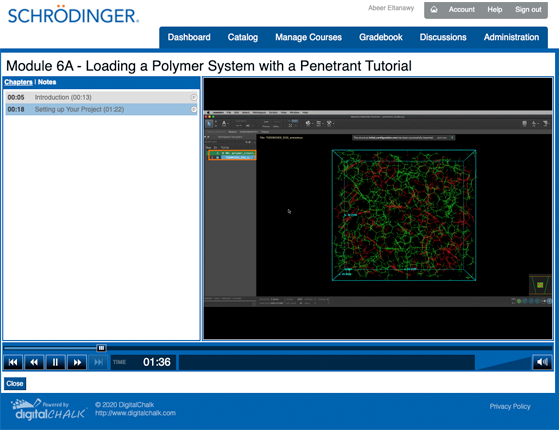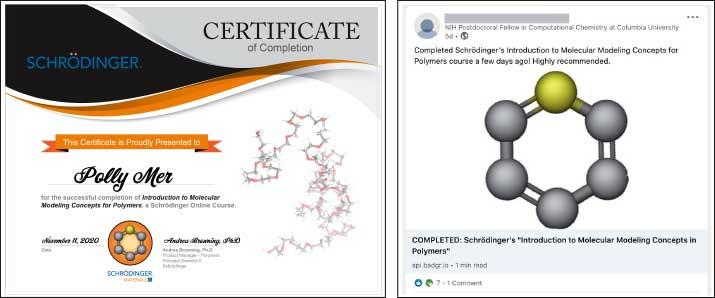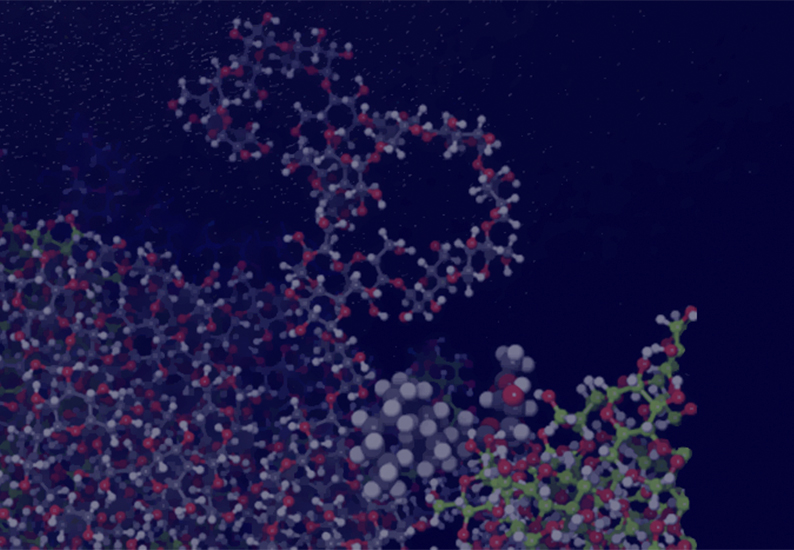The Schrödinger Online Learning Program has launched an online certification course for Polymeric Materials. This course teaches students how industry-leading computational molecular modeling tools are used to aid in polymer material development and design.
We spoke with Schrödinger’s Education Specialist, Abeer Eltanawy and Dr. Andrea Browning, Product Manager Polymers and Soft Matter in Schrödinger’s Materials Science group, to learn more about this course.
Why did Schrödinger decide to focus on polymer modeling for its next online course?
Abeer: One answer is simple, demand. There was a clear audience for a course on polymers and we had been asked about creating a course in materials science since nearly day one of launching our first online course.
Andrea: Polymers are some of the most commonly used materials and offer such variety in uses. Polymers are central to applications from advanced carbon-fiber composites and structural organics, to semiconductor and electronics manufacture and packaging. When we pair that with the fact that we have Schrödinger has a number of strong capabilities focused on providing insight into how polymers work in our Materials Science platform, an introduction to polymer modeling course was the clear next course to offer.
Can you briefly explain some of the core concepts a student will learn in this course?
Andrea: In this course, students will start by learning how molecular modeling for polymers can be valuable to them and what are important considerations. They will also learn some of the basic theory underlying molecular dynamics, which is the major simulation technique covered in the course. They will also learn how to use Materials Science (MS) Maestro and a collection of polymer focused builders and property based workflows. Finally, they will apply this knowledge in an assignment and case study.
How does this course serve both students new to polymer modeling and industry professionals?
Abeer: We take the student on a journey starting with the basic concepts of polymer modeling all the way to best practices on using molecular modeling tools to ideate, evaluate, and optimize a polymer. This course will help polymer scientists and polymer engineers hone their molecular modeling skills while helping researchers understand practical results versus theoretical results by providing examples using real life applications.
The webpage notes that books are not required for the course. Can you explain what kind of education materials students will have access to?
Andrea: The course includes summary presentations describing key concepts in polymer modeling, video tutorials, and self guided tutorials. The education material is designed to give students the information they need to get started on the different simulation activities covered in the course.
Each section also includes a list of key terms and additional readings. Students wanting to know more in particular areas can look to those additional readings including journal articles and textbooks so they are able to learn more.

The course description mentions that a student can use the tools they learn to apply in research projects. Can you describe how that would work?
Andrea: During the five-week time period of the course, students have access to the Schrödinger tools that are being taught including the polymer builders and property workflows like Thermophysical Properties, so they are able to actually apply what they are learning to a current project whether that’s in school or at their work. It helps solidify what they’re learning by using the tools in a real-world setting.
Do you provide any kind of certification upon completion of the course?
Abeer: Upon successful completion of the course, students receive a pdf Certificate of Completion as well an online badge. Online Badges are digital credentials that show you’ve completed a program, certifications, or course—like Schrödinger’s Online Courses. They can share the certificate and/or badge with their boss, instructor, or on Social Media platforms such as LinkedIn which would be viewable to potential employers or academic advisors.

There’s been a surge in interest for Schrödinger’s Introduction to Molecular Modeling in Drug Discovery course in the past several months. Dr. Jennifer Chambers, Schrödinger’s Director of Education, spoke about that in this blog, Learning and Collaborating From Home. Do you expect that this new course will offer the same benefits?
Abeer: Without a doubt, working from home has had a new meaning ever since the COVID-19 pandemic. As Dr. Chambers pointed out in the blog, the demand for online learning is here to stay. People are starting to realize how technology can be adapted into their busy lives, and our courses can be taken on your own schedule, wherever you are.
The Introduction to Molecular Modeling Concepts for Polymers course uses the same backend resources as with the Introduction to Molecular Modeling in Drug Discovery course, with the addition of utilizing modern techniques such as molecular dynamics on GPU using Schrödinger’s Materials Science platform hosted on a cloud instance created specifically for the user. The course offers a wide variety of pedagogical techniques — such as videos, tutorials, quizzes and assignments — and is entirely self-paced to help participants proceed with the course whenever is convenient to them.
What if a student has questions or runs into problems? What resources are available to them?
Abeer: There are various support options for students before and after the course session starts. Before the session, the course description page has full details on the course content. More information on the course’s sessions, requirements, prerequisites, and FAQ available on the registration page. Once the course starts, there is an additional FAQ element that helps the student proceed through the course. For module specific questions, there is a comment option for each module that students can use to communicate with the instructors. At any point, students can always reach out to online-learning@schrodinger.com with any inquiries.
What’s next for Schrödinger Online Learning?
Abeer: We are developing both an Introduction to High-Throughput Virtual Screening (HTVS) course and an Introduction to Antibody Modeling course. Both will be available in 2021. Anyone interested can sign up to get updates on course availability on our website. These courses fulfill a need that’s been in both the academic and commercial fields and we’re excited to help scientists advance their knowledge in molecular modeling.











